 |
|
|
|
#381 |
|
Where's my buffaloooo ...

|
Fingers crossed for herf honey!! Looks like they just need to cap a couple frames, and we should be able to harvest this week!
Posted via Mobile Device |
|
|

|
|
|
#383 | |
|
Admiral Douchebag

|
Quote:

__________________
 Thanks Dave, Julian, James, Kelly, Peter, Gerry, Dave, Mo, Frank, Týr and Mr. Mark! 
|
|
|
|

|
|
|
#384 |
|
Where's my buffaloooo ...

|
Grace and I removed the honey super this evening. I wish I had somebody taking video of the process because it went so much better than I could have imagined. The ladies were downright docile as we removed the frames and brushed them off.
Tomorrow Grace is taking the 10 frames to have the honey extracted and by tomorrow night we should have a butt load of honey. The box must weigh 40 or 50 pounds. Take away what little weight there is to the pine box plus the plastic frames, and I have to believe we have 30 to 40 pounds of actual honey. Hoping that we can get some pictures of the extraction process. With the herf this weekend, I don’t know if I’ll be able to post much in the next few days, but I’ll get the thread updated as soon as I can. Posted via Mobile Device |
|
|

|
|
|
#385 |
|
Article 4 Free Inhabitant

Join Date: Jan 2013
First Name: The Other Adam
Location: Satellite Beach
Posts: 14,787
Trading: (40)


          |
Well is that all honey or is a lot of that weight the actual wax is used for a ton of good stuff too. In Dublin the hotel we were at had this wood box at an angle with a plexiglass lid and in the box was raw honeycomb and you used a knife and just got fresh honey that way, it was pretty freaking cool
|
|
|

|
|
|
#386 |
|
Cigar Smokin' Patriot
|
 It looks like you are really good at this. Very satisfying when a lot of work pays off. It looks like you are really good at this. Very satisfying when a lot of work pays off.
__________________
Emancipate yourselves from mental slavery None but ourselves can free our minds |
|
|

|
|
|
#387 |
|
Admiral Douchebag

|
OK, so after breakfast with me, you, Dom, Keith, Roger and Christos, there should be at least 2 or 3 pounds left?

__________________
 Thanks Dave, Julian, James, Kelly, Peter, Gerry, Dave, Mo, Frank, Týr and Mr. Mark! 
|
|
|

|
|
|
#388 |
|
Where's my buffaloooo ...

|
So much super bee coolness went on today that I want to go on and on and on yadda yadda yadda about it all. But I have a herf to prep, so I'm just going to leave this here:
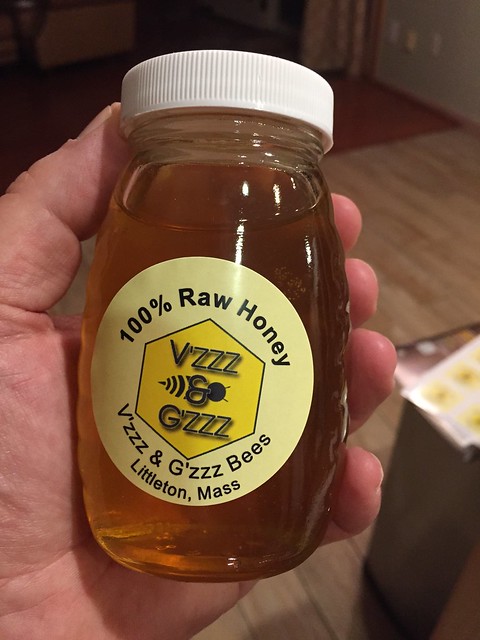
|
|
|

|
|
|
#391 |
|
Uncle Kitty

|
Hate to say it but Sweet!
 Perfect name for it! Perfect name for it!
__________________
"You stink like cigars Uncle Kitty!" Said my Boo age 3. "Kid, take care of your family and the hell with anyone else" My Grandpa Bubba. |
|
|

|
|
|
#392 |
|
Where's my buffaloooo ...

|
Probably not this first round -- gifting most of it to family friends -- though a jar may find it's way into the next troop auction.
 There's a second honey flow in the fall. If things go well, and we get another good-sized batch, we may look into selling some. There's an orchard right next door to us, and they have a farm stand. Our bees almost certainly have been working their flowers all spring & summer, and I think they might see the value in taking some honey on a consignment basis. |
|
|

|
|
|
#393 |
|
Sexy Dave

|
Nice job, Vin! Your hard work in keeping the hives thriving is paying off.
__________________
"Beer is proof that God loves us and wants us to be happy." - Benjamin Franklin I "heart" Boobies and Beer! 
|
|
|

|
|
|
#394 |
|
Admiral Douchebag

|
Roger killed on of the bees Friday. It was horrific.
__________________
 Thanks Dave, Julian, James, Kelly, Peter, Gerry, Dave, Mo, Frank, Týr and Mr. Mark! 
|
|
|

|
|
|
#395 |
|
Where's my buffaloooo ...

|
A few photos from the honey extraction ...
Grace brought our frames to a local beekeeper who has a serious set-up. Here's one of our frames being readied. You can see the ladies did an excellent job fully capping the whole frame. 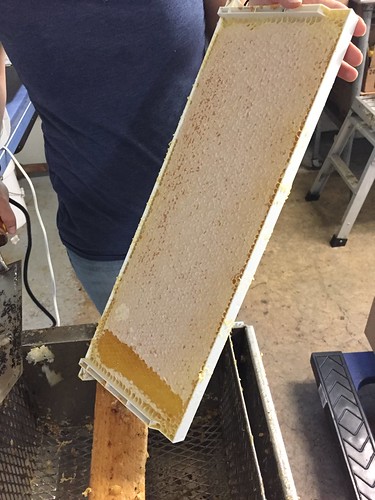 This is the same frame that's been uncapped. They use a heated knife to shear the wax away and it collects in a bin at the de-capping station. We get to keep the wax which can be used down the road for a variety of things from soap to candles to lip balm and more. 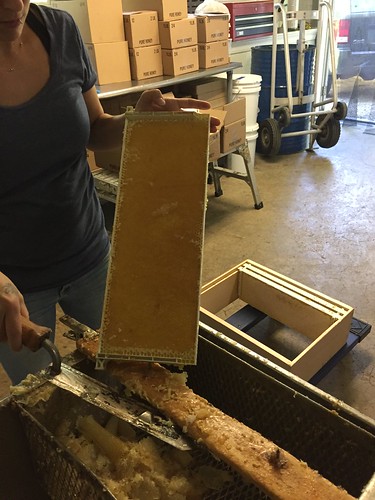 The frames are then loaded into an extractor which is basically a big stainless steel centrifuge that whirls them around to spin out the honey. The honey comb largely stays in tact during this process mostly because of the style frames I use. This is great for the bees -- less rebuilding of comb means more time can be spent making more honey. 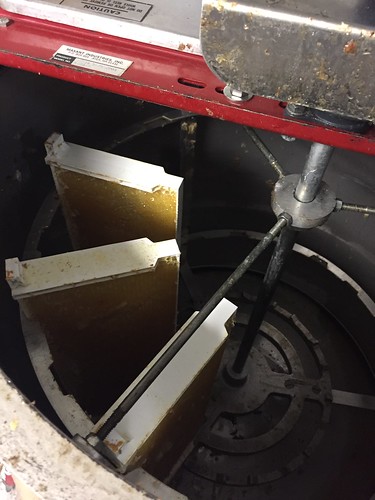 The honey pours from the extractor and is strained into a food grade 5-gallon bucket through a couple layers of steel mesh to filter out the bits of wax, bee parts and other assorted detritus. 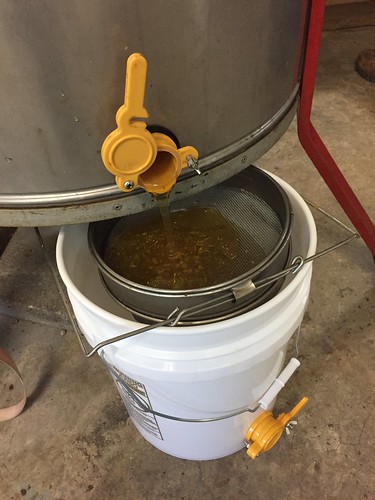 We ended up with just over 30 lbs of honey. (The bucket weighs about 2.5 lbs) 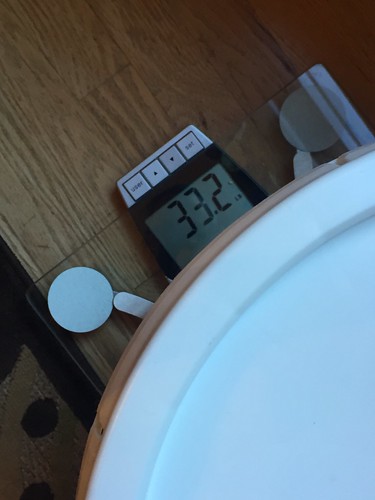 This was our honey filling station in the kitchen. You can see that 30 lbs is about half the bucket.  That 30 lbs was enough to gift everyone at my herf an 8 oz jar with plenty left over for family and friends. We'll see what the fall honey flow brings, and maybe I can make some available here. |
|
|

|
|
|
#399 |
|
Will herf for food
|
Great stuff Vin. That first batch of honey really is special. "Fall" honey is unique. You likely will have large amounts of goldenrod blooming in August. If the weather is right, it can produce large amounts of slightly darker honey. It's got a little stronger flavor as well. I love it. Keep the pics coming. If you can spare a half-pint or pint size jar of honey, I'd love to trade you jar for jar from my apiary. Every batch is different even from neighboring hives and I like tasting the different varieties. I'd love to try some New England honey if you're interested in some Michigan honey.
__________________
“Eating and sleeping are the only activities that should be allowed to interrupt a man's enjoyment of his cigar;” Mark Twain |
|
|

|
|
|
#400 | |
|
Where's my buffaloooo ...

|
Quote:
|
|
|
|

|
 |
| Thread Tools | |
| Display Modes | |
|
|